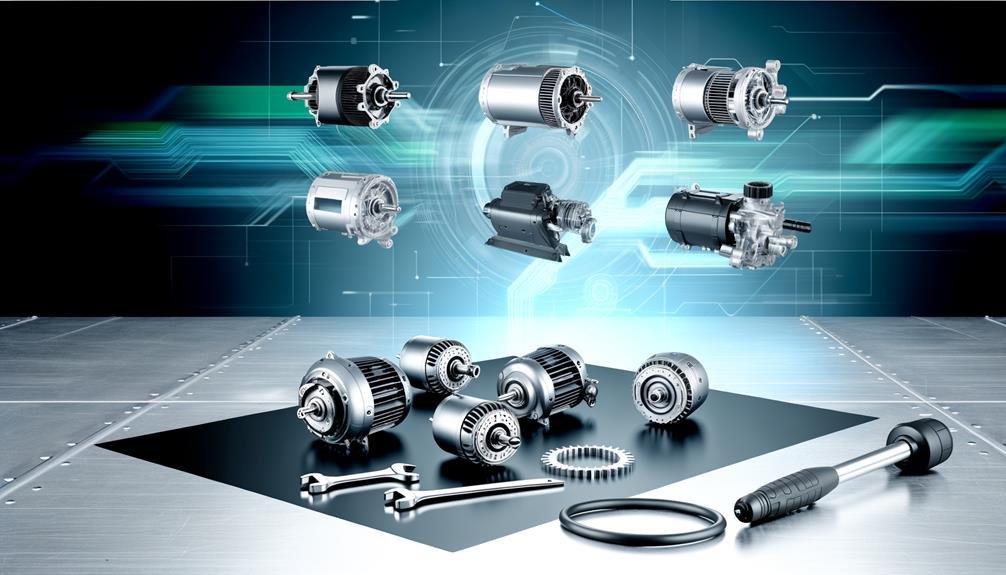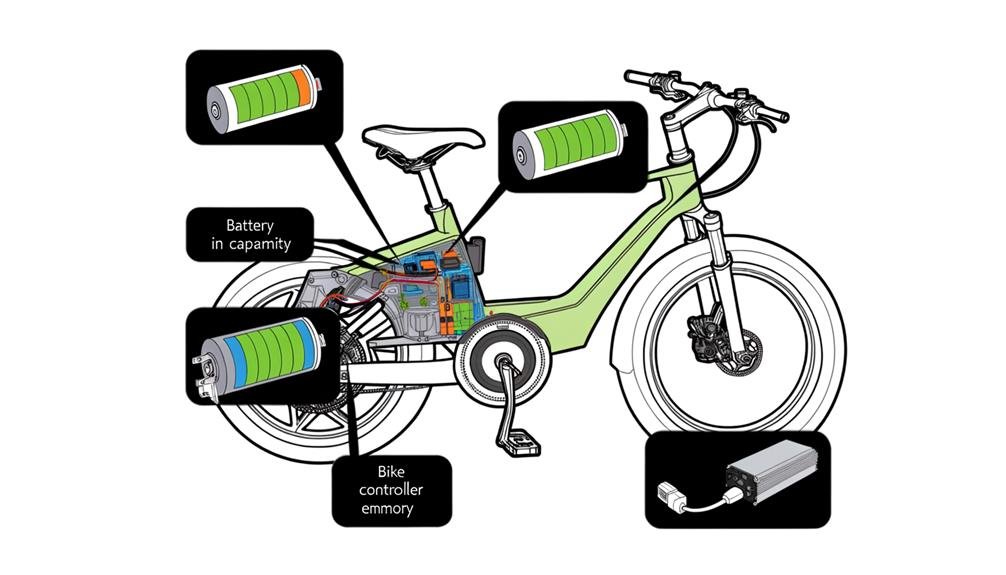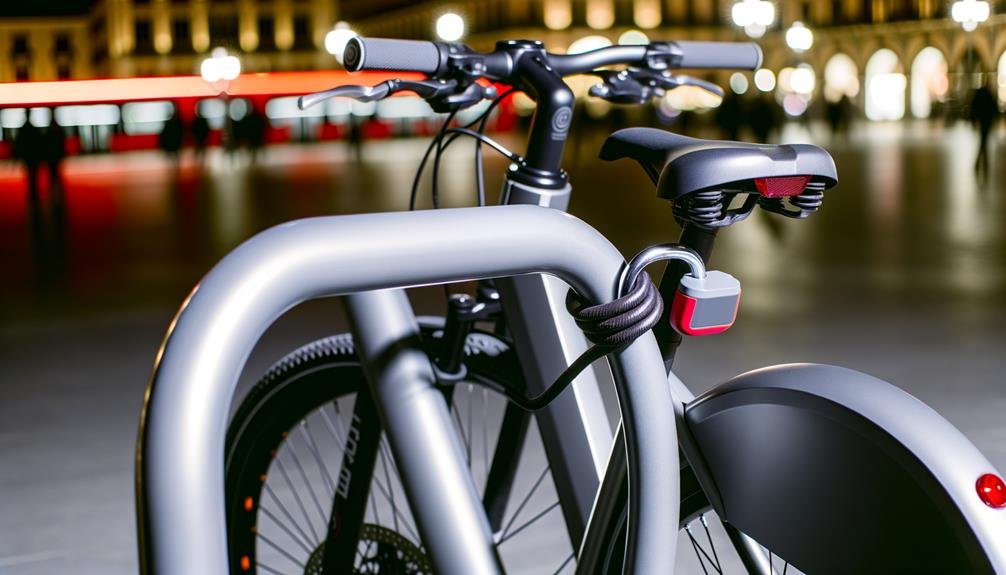Charles Miller is a veteran bike enthusiast with over 12 years of experience dealing with bikes as a mechanic. Despite immense love and expertise for...
As the old saying goes, 'Don't fix what ain't broken.' But in the world of ebikes, we're always looking for ways to improve performance and efficiency.
One question that often comes up is whether we can use a 52V battery on a 48V ebike. On the surface, it appears to be a simple upgrade. But, is it really that straightforward?
We'll need to consider several factors such as compatibility, potential benefits, risks, and manufacturer guidelines. Let's take a closer look, shall we?
- Key Takeaways
- Understanding Voltage Basics
- 52V Vs 48V Batteries
- The Role of Ebike Controller
- Compatibility of Batteries
- Benefits of 52V Batteries
- Manufacturer Guidelines Review
- Professional Installation Advantages
- Risk and Warranty Factors
- Legal and Safety Concerns
- Frequently Asked Questions
- Conclusion
Key Takeaways
- Higher voltage (52V) batteries can provide increased speed and improved torque compared to standard 48V batteries.
- Before considering switching to a 52V battery, the compatibility of the ebike must be assessed to avoid potential damage or ineffective functioning.
- Ebike controllers designed for 48V systems can typically handle 52V batteries, but using a higher voltage battery may cause the controller to heat up quicker.
- It is crucial to follow manufacturer guidelines, seek professional advice, and ensure legal compliance and safety when upgrading to a 52V battery on a 48V ebike system.
Understanding Voltage Basics
To truly grasp the potential of using a 52V battery on a 48V Ebike, we need to dive into the basics of voltage, which essentially determines the power output and speed of your electric bike. Voltage, in simplest terms, represents the force propelling electrons through the motor, thereby driving the ebike.
The standard voltage for ebikes is typically 48V, yet the prospect of upgrading to a 52V battery is becoming more enticing for enthusiasts. It's important to understand that higher voltage can lead to increased speed and improved torque, enhancing the overall performance of your ebike.
Let's consider a scenario where we switch from a 48V to a 52V ebike battery. With the higher voltage, the ebike's motor experiences a stronger push of electrons. This results in a quicker response, enabling the ebike to reach higher speeds with less strain on the motor.
In essence, understanding voltage basics in the context of an ebike battery allows us to see the potential benefits of a 52V system over a 48V one. It's not just about belonging to a group of ebike enthusiasts, but about maximizing the performance and enjoyment of your ride.
52V Vs 48V Batteries
Let's now compare and contrast 52V and 48V batteries in terms of performance, suitability, and compatibility.
We'll examine the increased power and speed offered by 52V batteries, against the potentially lighter weight and cost-effectiveness of 48V batteries.
Furthermore, we'll discuss how both batteries can perform with specific motors and controllers, and the implications of using a higher voltage battery with a 48V system.
Performance Comparison
When comparing the performance of 52V and 48V batteries in ebikes, we find that 52V batteries provide faster motor RPM and increased climbing power, while 48V batteries may be lighter and cheaper, offering compatibility with certain motors and controllers.
To enhance the performance of your Electric Bike, consider these key points:
- Running a 52V ebike offers faster speeds and longer distances, which many ebike owners seek.
- 48V batteries fit specific controllers and motors, providing both compatibility and safety.
- A dual battery system, combining a 52V with a 48V battery, provides a voltage overlap that allows for the best electric ride possible.
Suitability and Compatibility
In considering the suitability and compatibility of 52V and 48V batteries for ebikes, it's essential to understand that 52V batteries deliver faster motor RPM and improved hill-climbing power. However, the compatibility of your ebike must be assessed to ensure optimal performance.
Some ebikes are designed with specific voltage parameters and may not function effectively or could experience damage with a 52V battery. Therefore, it's crucial to assess the compatibility of your 48V ebike before considering a switch. Remember, professional advice is invaluable to avoid mishaps.
We must stress that while a 52V battery can offer enhanced performance, it must be suitable and compatible with your system. Making the right choice keeps your ebike running smoothly and efficiently.
The Role of Ebike Controller
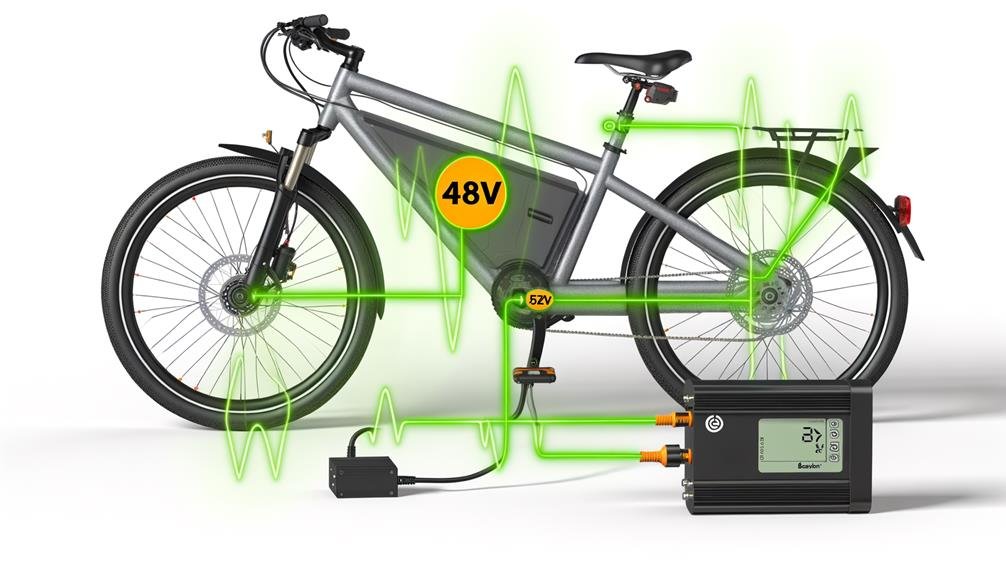
Navigating the role of the ebike controller, it's essential to know that this component plays a pivotal part in determining how a 52V battery operates on a 48V system. As one of the core e-bike components, ebike controllers manage the power distribution between the battery and the motor.
In the context of 'Can I use a 52v battery on a 48v ebike?', it's the controller that allows or limits this interchangeability. Here are three key points to understand:
- Controllers designed for 48V ebikes typically handle 52V batteries without issue. They regulate the increased voltage, ensuring optimal power output and protecting the motor from potential damage.
- A 52V battery can offer faster motor RPM and more power for riding into headwinds or up hills, thanks to the controller's regulation.
- However, using a 52V battery on a 48V system may cause the controller to heat up quicker. Though this won't pose a problem for short rides, prolonged usage may lead to overheating.
Compatibility of Batteries
As we venture further into the topic of using a 52V battery on a 48V Ebike, it's crucial to understand the compatibility of batteries.
We'll first tackle the nuances of battery voltages and the possible risks of overvoltage.
Ensuring safe usage will also be a key focus area, as we explore the technicalities and precautions associated with varying battery voltages.
Understanding Battery Voltages
To fully grasp the compatibility of batteries for ebikes, we need to delve into the concept of battery voltages. Understanding battery voltages is crucial to determine whether you can use a 52v battery on a 48v ebike.
- Ebike Voltage: This refers to the power output of your ebike's battery. A 48v ebike typically runs on a 48v battery.
- Battery Voltages: This is the measure of potential energy in a battery. A 52v battery holds more potential energy than a 48v battery.
- Compatibility: Not all ebikes can handle the extra voltage from a 52v battery. Over-volting can lead to overheating or damage to the ebike's motor.
Risks of Overvoltage
While most ebikes can handle a slight increase in voltage, it's essential to understand that using a 52v battery on a 48v ebike may pose certain risks, including possible damage to the motor due to overvoltage. This risk of overvoltage constitutes exceeding the recommended limits of the e-bike's electrical system, leading to potential damage.
Not all systems are designed to handle the increased voltage, and the extra strain can result in premature wear and tear. Furthermore, the overuse of a 52v battery may void warranties provided by the manufacturer, leaving you with the responsibility of any repairs or replacements needed.
We advise caution and thorough research before making any changes to your ebike's power system to avoid these potential risks.
Ensuring Safe Usage
Despite the potential risks, it's possible to safely use a 52V battery on a 48V ebike if you take certain precautions and ensure compatibility. We recommend following these steps:
- Consult the manufacturer's guidelines: Making sure the specifications of the motor can handle the higher voltage is crucial. This information can be found in the manufacturer's guidelines.
- Professional installation minimizes the risk: A professional can properly integrate the 52V battery with the 48V system, reducing the risk of damage and enhancing safety.
- Regular maintenance: Regularly checking the battery and the ebike can prevent potential issues from spiraling.
Benefits of 52V Batteries
If you're considering an upgrade for your ebike, 52V batteries can offer significant benefits, including faster motor RPM, increased power for hill climbing and headwind resistance, and a potentially longer range on a single charge. These benefits of 52V batteries can enhance your overall riding experience, making your 48V ebike more capable and versatile.
Let's break it down in the table below:
| Features | 48V Ebike | 52V Battery Upgrade |
|---|---|---|
| Motor RPM | Standard | Faster |
| Hill Climbing Power | Adequate | Increased |
| Range | Standard | Potentially extended |
Your 48V ebike's rear hub motor and controller should be able to handle the slightly elevated voltage parameters to ensure optimal performance. It's crucial, however, to confirm that your system is standard and capable of accommodating the 52V battery.
In a nutshell, swapping your 48V battery for a 52V one can add an extra punch to your ebike, helping you tackle steeper gradients, resist stronger headwinds, and enjoy longer rides between charges. Remember, the goal is to amplify your ebike's performance, ensuring you belong to a community of riders who value power, speed, and endurance.
Manufacturer Guidelines Review
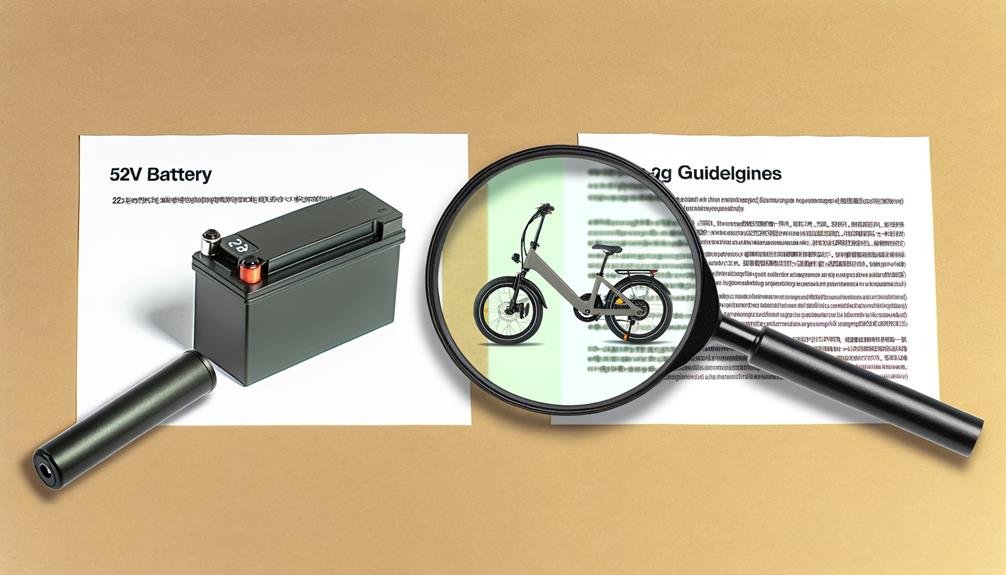
Before attempting to upgrade your ebike's battery, it's essential to thoroughly review the manufacturer's guidelines to understand the permissible voltage range. This review will help ensure that your 48v ebike can handle the power output from a 52v battery.
Here's a breakdown of the process:
- Understand the Voltage Parameters: Manufacturers provide specific voltage parameters to ensure optimal performance and range. Determining these parameters will guide you on the feasibility of the upgrade.
- Check the Components: Examine your ebike's motor, controller, and other components. They must be capable of supporting the increased voltage.
- Seek Professional Guidance: If unsure, consider professional installation. This step could save you from potential damage and voided warranties.
Professional Installation Advantages
Opting for professional installation when upgrading your ebike's battery to a 52V system offers significant advantages. Certified technicians can assess the compatibility of your existing 48V ebike system with the higher voltage battery. This ensures proper integration and reduces the risk of damaging components due to voltage mismatches or incorrect wiring.
Professional installation minimizes the risk of such mishaps, providing peace of mind and ensuring that the upgrade is carried out safely and in accordance with manufacturer guidelines. It's always a wise move to follow these guidelines and seek professional advice to avoid potential issues down the line.
The professionals can also provide guidance on selecting a suitable controller and making necessary adjustments to ensure seamless integration. They'll ensure that your ebike system is fully compatible with the new 52V battery, maximizing its performance and lifespan.
Risk and Warranty Factors
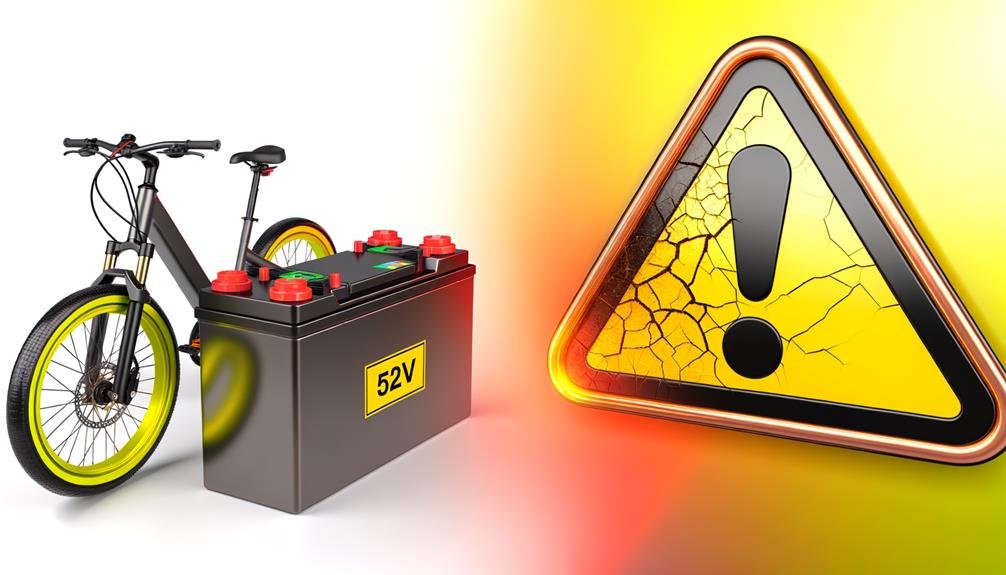
While it's tempting to boost your ebike's performance by upgrading to a 52V battery, it's crucial to consider the potential risks and warranty implications.
The allure of higher voltage can lead riders to contemplate upgrading, but it's essential to remember that surpassing recommended limits can lead to the risk of damage.
- Overvolting the controller and motor with a 52V battery might enhance performance but can also result in overheating, possibly voiding the warranty.
- Before making any modifications, it's advisable to consult the controller's compatibility. A mismatch can result in potential damage and warranty issues.
- Deviating from the manufacturer's recommended voltage range can void warranties and have legal implications.
It's crucial to ensure that the upgraded battery doesn't compromise the integrity of the electrical system. Adherence to legal and safety standards is paramount. Before modifying your ebike's original specifications, including the battery voltage, always consult the manufacturer's documentation.
This won't only help maintain your bike's warranty but also ensure its safety and performance. After all, belonging to the ebike community means riding responsibly and respecting the guidelines set by manufacturers.
Legal and Safety Concerns
Moving beyond the potential warranty issues, there's a pressing need to address the legal and safety concerns tied with upgrading to a 52V battery on a 48V ebike. It's not enough to understand the intricacies of voltage compatibility; we must also consider the parameters to ensure optimal performance and safety.
Your decision to upgrade to a 52V battery should be carefully weighed against potential legal implications. Some regions have strict regulations about altering the original specifications of an ebike. It's vital to stay within the bounds of the law to maintain your belonging in the community.
Here's a quick guide to consider:
| Concerns | Recommendations |
|---|---|
| Legal | Check local regulations before deciding to upgrade. |
| Safety | Ensure the 52V battery doesn't compromise the ebike's electrical integrity. |
| Performance | Monitor the 52V battery's performance in the 48V ebike system. |
Safety is paramount when enhancing the overall safety of your ebike. Ensure that your upgraded 52V battery doesn't compromise the electrical system's integrity. Adhere to these guidelines and make an informed decision about upgrading your 48V ebike with a 52V battery.
Frequently Asked Questions
Can I Use a 52V Battery With a 48V Motor?
Yes, we can use a 52V battery with a 48V motor. It'll improve motor efficiency and performance impact. However, we must consider voltage limits, safety measures, battery lifespan, and maintenance implications for compatibility.
Can I Run a 60V Battery on a 48V Motor?
We're playing with fire here! Voltage compatibility is crucial to avoid motor damage or battery overheating. A 60V battery on a 48V motor impacts performance, energy efficiency, and safety measures. It could shorten battery lifespan too.
Can I Use a 36v Battery With a 48V Motor Ebike?
We wouldn't recommend it. A voltage mismatch can lead to battery safety issues, reduced motor performance, and shorter battery lifespan. It could also cause power output discrepancies and charging problems. Always prioritize battery compatibility.
Can a 48V Controller Handle 72v?
We'd caution against a 72V battery on a 48V controller. Controller limitations and voltage compatibility are key. Over voltage risks include controller damage. Always prioritize safety precautions and efficient usage for optimal battery performance.
Conclusion
In wrapping up, remember, it's not just about 'Can we?' but 'Should we?' when considering a 52V battery for your 48V ebike. Always weigh the benefits against potential risks, review manufacturer guidelines, and seek professional advice.
Above all, safety first. Because, while the thrill of the ride is exhilarating, the journey is only as good as the care we invest in our gear.
Let's ride smart, folks!

Charles Miller is a veteran bike enthusiast with over 12 years of experience dealing with bikes as a mechanic. Despite immense love and expertise for his Tacoma, he rides his Trek Ebike more. Anytime you meet him, you’ll either hear him talking about Bikes, or writing about all things bikes and cars on this blog.
More Posts
